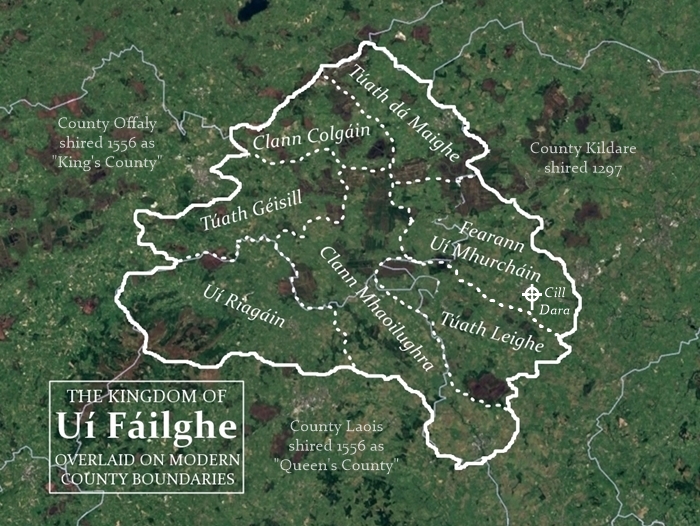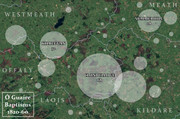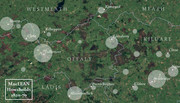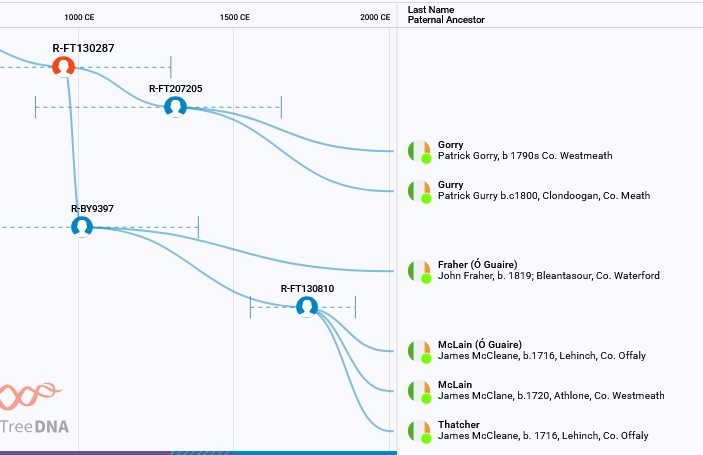1
Kilkenny / QUARRY/QUERRY/WHERRY/WARRY for Y-DNA Research
« on: Saturday 27 September 25 17:53 BST (UK) »
Good afternoon rootschat,
My name is Chris McLain and I'm descended of a James Quarry who was orphaned in the Dublin Liberties in the early 18th c and taken in by maternal relatives named McClane. I'm also the admin for the Cenel Brenainn DNA group, https://www.familytreedna.com/groups/mc-govern/activity-feed which pertains to the larger Ui Briuin kindred to which the Mac Guaire (Gorry/Gurry/Gorey/Quarry) surname belongs. I am looking for any man with "Quarry"/"Warry" variant surname who has a papertrail to Kilkenny that is interested in Y-DNA research, the cost of which would be completely on me. I am willing to purchase a BigY700 test and send him the kit.
The Quarry surname was largely "GOREY" in Kilkenny, but my latest research on my specific line is tending to line up with a family that anglicized to variants which ended up as Quarry or Warry, who were likely craftsmen from Kilkenny that migrated into Dublin. Below is our 6-member kin-group's BigY700 results tree from FamilyTree DNA.

As you can see, the "Fraher" member is also a Quarry but that timeframe and link is undetermined. He is likely descended from the Quarry family around Dungarvan.
The Mac Guaire family is often confused with the Scottish family of the same name. It was only recently after a lot of research that I was able to determine that this family has two distinct branches. One in N. Leinster, originally seated at Kildare and the other in S. Leinster/Ossory who I believe came into the area in pre-Norman times, possibly associated with Kilree. I now have substantial evidence that the MacGuaire/Ui Guaire family were erenaghs, that is hereditary stewards of monastic lands. We all descend from one Ui Guaire man who lived approximately in the mid 10th century which also lines up with an entry in the Annals of the Four Masters:
962: Cairbre Ua Guaire, head of the hospitality of Leinster, died.
This is a high-status lay-ecclesiastic office connected to Saint Brigid's monastery at Kildare. His death was the result of a Norse raid on Kildare at the end of 961 where much of the monastic community was carried off and held for ransom, many of them being killed.
Early records in Kilkenny, which at the time was the Earldom of Ormond, show the surname already spread out. In 1338, a "John McGuydy" witnessed a land deed concerning Ballyanne Co. Wexford on the Barrow. In 1364 a "Robert McUre" was fined 6s. and forfeited goods by the Sheriff of the Liberty of Tipperary. In a 1507 episcopal deed concerning property of Kells priory, one "Donaldus O Gowre" (Domhnaill Ua Guaire) and "Phillipus O Gowre" (Pilib Ui Guaire) were "testi antiqui", that is community elders who farmed the Grange of Kells (Kellsgrange, Co. Kilkenny) who testified that they had memory of the curtain walls and towerhouses of Kells priory being built (this occurred in the 1460s/70s). Three townlands in Leinster are connected to this kindred:
Clongorey, Co. Kildare, Tullygorey, Co. Kildare, and Ballygorey, Co. Kilkenny. All three have ruins of small medieval chapels and two of the three have holy wells. Clongorey itself was property of St. Brigid's monastery until the dissolution. All these facts spell out erenagh behavior and settlement.
Several of the Tudor Fiants in Kilkenny line up with the "Quarry" variant surname:
27 Apr 1561. William O'Quoddy, husbandman, of Dunnamaggan, Co. Kilkenny (F.Eliz.415)
9 Dec 1565. Grant of English liberty to Maurice Qwade, sailor, of Waterford (F.Eliz.786)
20 Jul 1574. Morgan Weyry, carpenter. John Weyry, glover, both of Kilkenny (F.Eliz.2424)
Phonetically some of these are confusing. I believe MacQuarry with the rolled "r" anglicized to "Quoddy"(Quarry) very early and then regaelicized with an O-prefix. Also, Dunnamaggan was monastic property of Kells priory until the dissolution. The pardon of Wm O'Quoddy shows continuity with the "OGowre" testi antiqui in 1507. Weyry is certainly "MacWeyry" with a prefix-drop, possibly just legal cover in a very anglicized place post-dissolution in the tudor era.
19th century parish records show a number of Quarry/Weary variants around Kilkenny city, and a few Quarry families scattered around Ballyhale just south of Kells. There seems to be much more of this name southward in Waterford and Cork possibly suggesting a coastal maritime migration, which may also how they came into Dublin.
I would very much like to connect the Kilkenny Quarry family to the rest of us and not only see where they fall on our tree, which would give a timeframe of Kilkenny settlement, but also to put more puzzle-pieces together of this larger family. If any of you have Quarry/Warry relatives from the area who would be interested, you can reply to this post or sent me a private message. Also, although I'm not specifically looking for Gorry/Gurry/Gorey participants as it pertains to my own specific line, all of these variants would be kin to the greater MacGuaire family. If any Goreys are interested in joining the group and getting started with Y-DNA research, please contact me as well, I'll tell you how to get started and I'd love to have you aboard.
Thank you,
Chris McLain
My name is Chris McLain and I'm descended of a James Quarry who was orphaned in the Dublin Liberties in the early 18th c and taken in by maternal relatives named McClane. I'm also the admin for the Cenel Brenainn DNA group, https://www.familytreedna.com/groups/mc-govern/activity-feed which pertains to the larger Ui Briuin kindred to which the Mac Guaire (Gorry/Gurry/Gorey/Quarry) surname belongs. I am looking for any man with "Quarry"/"Warry" variant surname who has a papertrail to Kilkenny that is interested in Y-DNA research, the cost of which would be completely on me. I am willing to purchase a BigY700 test and send him the kit.
The Quarry surname was largely "GOREY" in Kilkenny, but my latest research on my specific line is tending to line up with a family that anglicized to variants which ended up as Quarry or Warry, who were likely craftsmen from Kilkenny that migrated into Dublin. Below is our 6-member kin-group's BigY700 results tree from FamilyTree DNA.

As you can see, the "Fraher" member is also a Quarry but that timeframe and link is undetermined. He is likely descended from the Quarry family around Dungarvan.
The Mac Guaire family is often confused with the Scottish family of the same name. It was only recently after a lot of research that I was able to determine that this family has two distinct branches. One in N. Leinster, originally seated at Kildare and the other in S. Leinster/Ossory who I believe came into the area in pre-Norman times, possibly associated with Kilree. I now have substantial evidence that the MacGuaire/Ui Guaire family were erenaghs, that is hereditary stewards of monastic lands. We all descend from one Ui Guaire man who lived approximately in the mid 10th century which also lines up with an entry in the Annals of the Four Masters:
962: Cairbre Ua Guaire, head of the hospitality of Leinster, died.
This is a high-status lay-ecclesiastic office connected to Saint Brigid's monastery at Kildare. His death was the result of a Norse raid on Kildare at the end of 961 where much of the monastic community was carried off and held for ransom, many of them being killed.
Early records in Kilkenny, which at the time was the Earldom of Ormond, show the surname already spread out. In 1338, a "John McGuydy" witnessed a land deed concerning Ballyanne Co. Wexford on the Barrow. In 1364 a "Robert McUre" was fined 6s. and forfeited goods by the Sheriff of the Liberty of Tipperary. In a 1507 episcopal deed concerning property of Kells priory, one "Donaldus O Gowre" (Domhnaill Ua Guaire) and "Phillipus O Gowre" (Pilib Ui Guaire) were "testi antiqui", that is community elders who farmed the Grange of Kells (Kellsgrange, Co. Kilkenny) who testified that they had memory of the curtain walls and towerhouses of Kells priory being built (this occurred in the 1460s/70s). Three townlands in Leinster are connected to this kindred:
Clongorey, Co. Kildare, Tullygorey, Co. Kildare, and Ballygorey, Co. Kilkenny. All three have ruins of small medieval chapels and two of the three have holy wells. Clongorey itself was property of St. Brigid's monastery until the dissolution. All these facts spell out erenagh behavior and settlement.
Several of the Tudor Fiants in Kilkenny line up with the "Quarry" variant surname:
27 Apr 1561. William O'Quoddy, husbandman, of Dunnamaggan, Co. Kilkenny (F.Eliz.415)
9 Dec 1565. Grant of English liberty to Maurice Qwade, sailor, of Waterford (F.Eliz.786)
20 Jul 1574. Morgan Weyry, carpenter. John Weyry, glover, both of Kilkenny (F.Eliz.2424)
Phonetically some of these are confusing. I believe MacQuarry with the rolled "r" anglicized to "Quoddy"(Quarry) very early and then regaelicized with an O-prefix. Also, Dunnamaggan was monastic property of Kells priory until the dissolution. The pardon of Wm O'Quoddy shows continuity with the "OGowre" testi antiqui in 1507. Weyry is certainly "MacWeyry" with a prefix-drop, possibly just legal cover in a very anglicized place post-dissolution in the tudor era.
19th century parish records show a number of Quarry/Weary variants around Kilkenny city, and a few Quarry families scattered around Ballyhale just south of Kells. There seems to be much more of this name southward in Waterford and Cork possibly suggesting a coastal maritime migration, which may also how they came into Dublin.
I would very much like to connect the Kilkenny Quarry family to the rest of us and not only see where they fall on our tree, which would give a timeframe of Kilkenny settlement, but also to put more puzzle-pieces together of this larger family. If any of you have Quarry/Warry relatives from the area who would be interested, you can reply to this post or sent me a private message. Also, although I'm not specifically looking for Gorry/Gurry/Gorey participants as it pertains to my own specific line, all of these variants would be kin to the greater MacGuaire family. If any Goreys are interested in joining the group and getting started with Y-DNA research, please contact me as well, I'll tell you how to get started and I'd love to have you aboard.
Thank you,
Chris McLain




